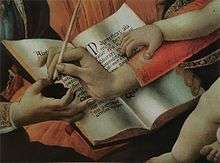Writing-riddle
The writing-riddle is an international riddle type, attested across Europe and Asia. Its most basic form was defined by Antti Aarne as 'white field, black seeds', where the field is a page and the seeds are letters.[1] However, this form admits of variations very diverse in length and degree of detail. For example, a version from Astrakhan translates as "the enclosure is white, the sheep are black", while one from the Don Kalmyks appears as "a black dog runs on white snow",[2] and literary riddlers especially have produced long variations on the theme, often overlapping with riddles on pens and other writing equipment.

Significance
Literary riddles have been particularly prized by scholars for the insights they give into how past writers have conceptualised the act of writing.[3][4][5]
Anglo-Saxon examples
One of the Old English riddles of the Exeter book is a variations on the writing-riddle: Exeter Book Riddle 51. Earlier and more frequent examples appear among Anglo-Latin riddles, however, as follows.
Aldhelm, c. C7, ‘De pugullarbius’ (‘on wax tablets’)
Melligeris apibus mea prima processit origo. |
My inner part came from honey-bearing bees, |
Aldhelm (c. C6), ‘De penna scriptoris’ (‘On the writer’s quill’)
Me dudum genuit candens onocratulus albam |
I am shining white, born long ago of the gleaming pelican, |
Tatwine (C8), Enigma 5, 'De membrano' ('on parchment')
Efferus exuviis populator me spoliavit, |
A savage ravager robbed me of my clothing, |
Romance examples
The writing riddle was very popular in the Romance languages,[9] and indeed arguably the first attestation of a language written in Romance rather than Latin is the eighth- or ninth-century Veronese Riddle:
Se pareba boves |
In front of him (he) led oxen |
Here, the oxen are the scribe's finger(s) and thumb, and the plough is the pen. Among literary riddles, riddles on the pen and other writing equipment are particularly widespread.
This French version is attested in a fifteenth-century manuscript:
Blanc est le champ, |
White is the field, |
And these versions are attested in the French creole of Mauritius:
Latére blanc, lagrains noir? |
The earth is white, the seed black? |
Pen riddles
Pen riddles are to a greater or lesser extent allied to the traditional writing riddle. Examples of pure pen-riddles include the Old English Exeter Book Riddle 60, two by the tenth-century Hebrew-language poet Dunash ben Labrat, and others follow.
Palatine Anthology (Greek)
I was a reed, a useless plant; for from me is born neither fig nor apple nor grape; but a man initiated me into the ways of Helicon, having shaped fine edges and having carved out a narrow channel. From then, should I drink black liquid, as if inspired, with this dumb mouth I utter every kind of word.[12]
Symphosius (c. C4) ‘Harundo’ (‘reed’) (Latin)
Dulcis amica ripae, semper uicina profundis, |
Sweet darling of the banks, always close to the depths, sweetly I |
This poem adverts to the use of reeds for making pipes as well as pens.[14]
Al-Harīrī of Basra (1054–1122) (‘reed-pen’) (Arabic)
One split in his head it is, through whom ‘the writ’ is known, as honoured recording angels take their pride in him;
When given a drink he craves for more, as though athirst, and settles to rest when thirstiness takes hold of him;
And scatters tears about him when he bids him run, but tears that sparkle with the brightness of a smile.
Judah Halevi (Hebrew)
What's slender, smooth and fine,
and speaks with power while dumb,
in utter silence kills,
and spews the blood of lambs?[15]
References
- Antti Aarne, Vergleichende Rätselforschungen, 3 vols, Folklore Fellows Communications, 26–28 (Helsinki/Hamina: Suomalainen Tiedeakatemia, 1918–20), I 35–73 (p. 35).
- Archer Taylor, 'The Riddle', California Folklore Quarterly, 2 (1943), 129–47 (p. 137).
- Luke Powers, "Tests for True Wit: Jonathan Swift's Pen and Ink Riddles", South Central Review, 7.4 (Winter 1990), 40–52; doi:10.2307/3189093. JSTOR 3189093.
- Helen Price, 'Human and NonHuman in Anglo-Saxon and British Postwar Poetry: Reshaping Literary Ecology' (unpublished doctoral thesis, University of Leeds, 2013), pp. 92–128.
- Catherine Brown, ‘Scratching the Surface’, Exemplaria: Medieval, Early Modern, Theory, 26 (2014), 199–214.
- Through a Gloss Darkly: Aldhelm’s Riddles in the British Library ms Royal 12.C.xxiii, ed. and trans. by Nancy Porter Stork, Pontifical Institute of Mediaeval Studies, Studies and Texts, 98 (Toronto: Pontifical Institute of Mediaeval Studies, 1990), pp. 137–38.
- Through a Gloss Darkly: Aldhelm’s Riddles in the British Library ms Royal 12.C.xxiii, ed. and trans. by Nancy Porter Stork, Pontifical Institute of Mediaeval Studies, Studies and Texts, 98 (Toronto: Pontifical Institute of Mediaeval Studies, 1990), p. 176.
- Variae collectiones aenignmatvm Merovingicae aetatis (pars altera), ed. by Fr. Glorie, Corpvs Christianorvm, Series Latina, 133a (Turnholt: Brepols, 1968), p. 172.
- Archer Taylor, The Literary Riddle before 1600 (Berkeley, CA: University of California Press, 1948).
- E. Rolland, Devinettes ou énigmes pop. de la France (1877), p. 106.
- Charles Baissac, Le Folk-lore de l'Ile-Maurice, Les Littératures Populaires de Toutes les Nations, 27 (Paris: Leclerc, 1888), p. 415.
- Symphosius, The Aenigmata: An Introduction, Text and Commentary, ed. by T. J. Leary (London: Bloomsbury, 2014), p. 67: Palatine Anthology, 9.162.
- Variae collectiones aenignmatvm Merovingicae aetatis (pars altera), ed. by Fr. Glorie, Corpvs Christianorvm, Series Latina, 133a (Turnholt: Brepols, 1968), p. 623.
- Symphosius, The Aenigmata: An Introduction, Text and Commentary, ed. by T. J. Leary (London: Bloomsbury, 2014), p. 66.
- The Dream of the Poem: Hebrew Poetry from Muslim and Christian Spain, 950–1492, ed. and trans. by Peter Cole (Princeton: Princeton University Press, 2007), p. 150.